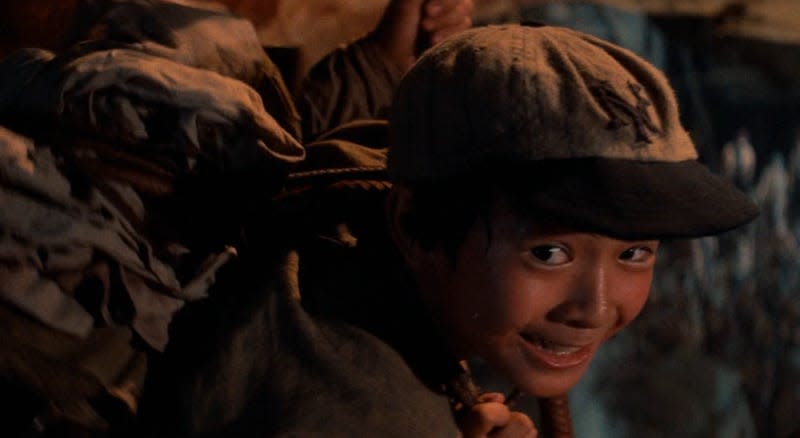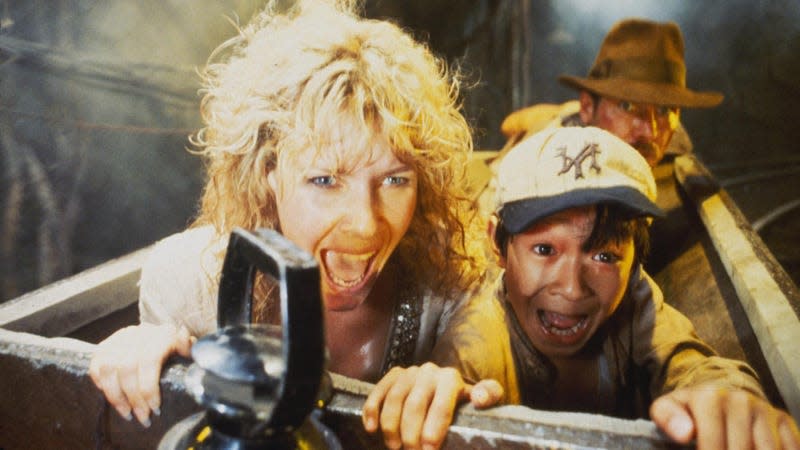Indiana Jones and the Temple of Doom Is 2 Brilliant Movies Mashed Into One

- Oops!Something went wrong.Please try again later.
- Oops!Something went wrong.Please try again later.
Of all the Indiana Jones movies, I’ve seen Temple of Doom the most. Between a worn-out VHS copy and watching on TV, I’ve probably seen it 100 times. I know every wink, every expression, every inflection of every line reading. I love it unconditionally and figured, watching it again in the lead-up to Indy’s fifth and Indiana Jones and the Dial of Destiny, I wouldn’t really find much to talk about. I was wrong.
In the weeks ahead, io9 is going to revisit each of the Indiana Jones films just to see what, if anything, stands out about them now, in 2023, as Dial of Destiny is coming to theaters. Last week it was Raiders of the Lost Ark, widely considered to be one of the best action films ever made. Temple of Doom doesn’t hold that distinction, and it’s easy to see why. It’s like a whole other genre of movie.
Read more
Rewatching Temple of Doom today, you can’t help but look at it through the window of many modern franchises. Franchises that stick to the same formula every single time, and the choice few that don’t. On the surface, Temple of Doom is an Indiana Jones movie. That much is clear. But it’s not at all a film that feels like its predecessor. From the very opening of the film, with its Busby Berkeley-inspired song and dance, through the screwball comedy of the first hour, which then takes a hard pivot into almost horror before a character literally looks at you, smiles, and things get back to action adventure, it’s a beautiful symphony of genre and tone. One where all bets are off, all realities are unimportant, and you just enjoy the ride.

The first clue to the film’s purposeful irreverence is in that opening musical number. First of all, it’s called “Anything Goes,” which pretty much says it all. But also, while things start in the actual club the scene takes place in—Club Obi-Wan, for you Star Wars fans out there—when Willie Scott (Kate Capshaw) walks into a statue, the film relocates to an alternate reality. Where are all these leggy blond women dancing? It’s certainly not in a club in 1935 Shanghai. But it doesn’t matter; it’s beautifully staged, choreographed, and when Willie reemerges back to the club, director Steven Spielberg has set you up for excitement.
After not one (the club), not two (the car chase), but three (the plane crash) action sequences where you can barely catch your breath, we finally find out the story of the movie: a small, poor Indian village has had its children taken from it, as well as a rock which residents believe gives life to the land. The villagers also think that Indy (Harrison Ford) was sent to save them by their deity, Shiva. Which, on the one hand, seems a little silly. But watching the film again, I think I now believe the villagers. (Temple of Doom’s portrayal of the villagers and the surrounding community isn’t always, shall we say, culturally sensitive—not entirely surprising for a movie made four decades ago, but something that might stand out for a first-time viewer in 2023.)
Look at the evidence. The villagers prayed for someone to help them. Then, out of nowhere, a man who knows all about their magic rock falls out of the sky into their village. Indy’s plane could have run out of gas anywhere. The raft they used to get out could have landed anywhere. The river the raft was in could have taken them anywhere. But no, somehow the perfect person to do the job was right where he needed to be. Later, when the film shows that magic and otherworldly forces do exist, that all but seals it. I’ll never watch Temple of Doom again without believing Shiva did, in fact, send Indy.

That’s about as serious things get in this section of the movie though. After Indy decides to go to the palace where this is all happening, we’re given this incredibly beautiful but also incredibly silly extended sequence of Indy, Short Round (future Oscar winner Ke Huy Quan, in his feature debut), and Willie traveling through the jungle, complete with wild animals, over-the-top screams, gambling, cheating, and all manner of jokes. It feels like a comedy and the comedy continues once they arrive at the palace.
The early scenes at the palace are some of my favorite movie scenes ever. The unforgettable dinner sequence is gross but wildly funny. Indy and Willie’s romantic flirting is completely over the top but still somehow sexy. And, finally, Indy and Short Round’s journey into the caves, with the bugs and the spikes and all that good stuff, is all handled with a knowing wink. Everything is fun, exciting, and silly.
Then, at almost exactly the one-hour mark (which is probably a coincidence but is still interesting), Indy and his friends find the underground Thuggee cult and the movie turns on a dime. For the next 20 or so minutes, we’re presented with some of the most terrifying, disgusting, upsetting imagery imaginable, especially for a PG movie. A heart is ripped out, a body goes up in flames, Indy is flogged and possessed, children are beaten, and people drink blood. This is not the same movie where a character screams at a giant animal and throws a snake because she thinks it’s an elephant trunk. This is dark disturbing stuff.

A turning point moment.
But Spielberg knows this. Short Round escapes, John Williams’ rousing music starts playing again, and after he gets up the ladder, Short Round looks into the camera and smiles. It’s a funny moment that kind of just passed me by in previous watches but this time, at this moment, I read it differently. I read Short Round’s expression almost as Spielberg himself saying “Sorry about all that, let’s get back to the fun stuff.” Because after the smile, Temple of Doom gets back to business.
Short Round saves Indy, Indy saves Willie, they save the kids, a Thuggee bad guy is crushed in a steamroller, then there’s the super-duper awesome (but not at all realistic) mine cart sequence. The movie is back to its adventurous first-half tone, culminating in the gorgeously staged, but still funny and scary, bridge sequence where Indy kills the bad guy and saves the day, another personal favorite.

Finally, to really drive it all of this home, Temple of Doom has one of the happiest endings ever. Not only does Indy win. Not only do the bad guys lose. Not only does Indy get the stone. All of the village’s kids return in a joyous outpouring of emotion that’s just the cherry on top of this wild, incredible ride. As Paul Simon said, “the mother and child reunion is only a motion away.”
The magic of Indiana Jones and the Temple of Doom is how big it swings. It knows we loved Raiders of the Lost Ark but it trusts us to go on an adventure that’s even wilder, hitting on all different notes. Maybe that’s why some people don’t like it as much, and why the subsequent Indiana Jones and the Last Crusade went back to a similar structure and tone as the original. But to me, Temple of Doom is the Indiana Jones—both the character and the movie—that I love most.
Indiana Jones and the Temple of Doom is available to stream on both Disney+ and Paramount +. Next week: Indiana Jones and the Last Crusade.
Want more io9 news? Check out when to expect the latest Marvel, Star Wars, and Star Trek releases, what’s next for the DC Universe on film and TV, and everything you need to know about the future of Doctor Who.
More from Gizmodo
Sign up for Gizmodo's Newsletter. For the latest news, Facebook, Twitter and Instagram.

